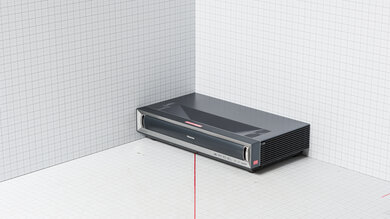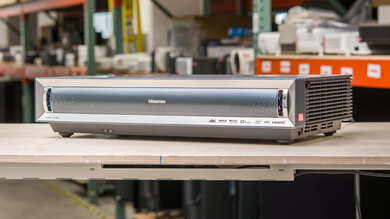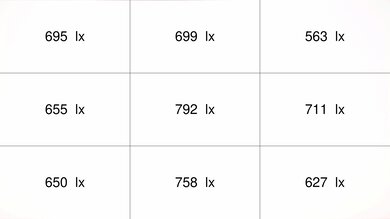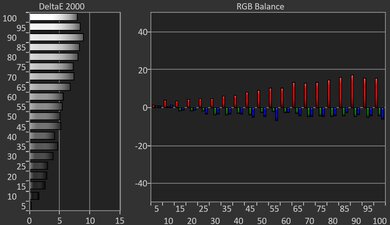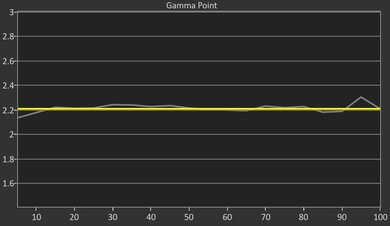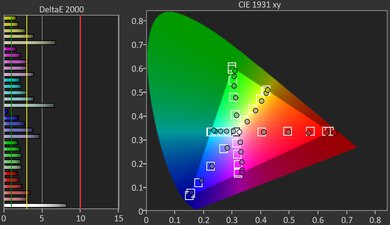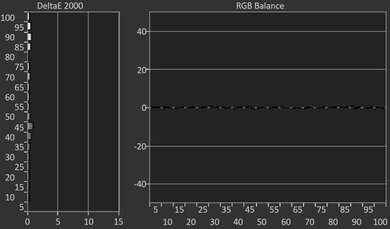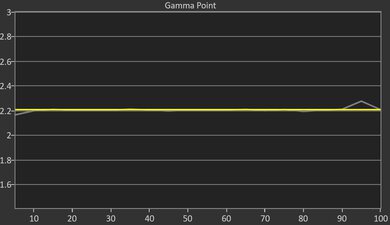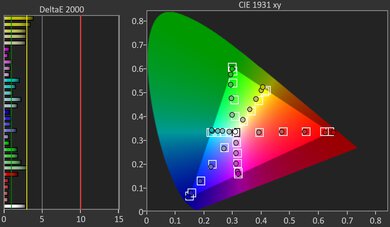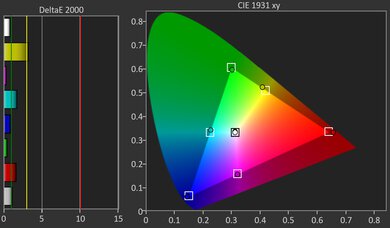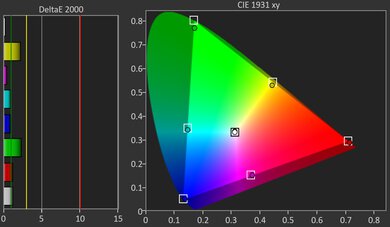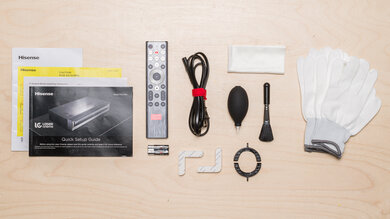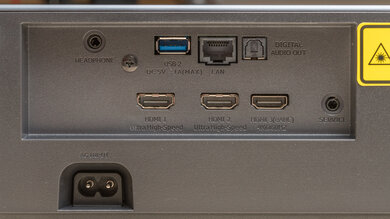The Hisense PX3-PRO is an Ultra Short Throw (UST) 4k HDR laser projector, and it succeeds the Hisense PX2-PRO and Hisense PX1-PRO. It's a fully featured projector with Dolby Vision, HDR10+, and Dolby Atmos support, providing an immersive HDR viewing experience. It's also certified as being 'Designed for Xbox,' which means that it comes with a low-latency mode and is capable of gaming up to 240Hz in 1080p and 60Hz at 4k through its two HDMI 2.1 ports. It also has an HDMI 2.0 port, which doubles as the unit's eARC port.
As it's a UST projector, it displays content at an extremely short distance from the screen or wall: it projects a 90-inch image at a distance of 6.6 inches and up to a 130-inch image at a distance of 14.3 inches. It has Bluetooth and Wi-Fi support and comes with the Google TV smart interface with full Chromecast and AirPlay 2. Finally, it has a 50W Harman Kardon sound system.
Our Verdict
The Hisense PX3-PRO is a great projector for watching movies. It's bright enough for rooms with a few lights, and it's also bright enough to project bright and punchy colors, especially with its extremely wide color gamut. Its contrast is impressive, so it truly excels in darker rooms. It's also a fully featured projector with Dolby Vision, HDR10+, and Dolby Atmos support, making it very versatile. Its pre-calibration image accuracy is mediocre; however, as the unit's color temperature is noticeably too warm and out-of-the-box, those who care about accuracy will want to calibrate it for the best possible experience.
-
Very good peak brightness, with bright and punchy colors.
-
Impressive contrast for a great dark room experience.
-
Ultra short throw capabilities, so you can place it very close to the wall or screen.
-
Packed with features for movies and gaming.
-
White balance is noticeably warm out-of-the-box.
- 8.1 Movies
Changelog
-
Updated May 16, 2025:
We mentioned the newly reviewed Valerion VisionMaster Pro 2 in the Brightness section of this review.
-
Updated Feb 10, 2025:
We mentioned the newly reviewed XGIMI AURA 2 in the Pre-Calibration Color Accuracy section of this review.
- Updated Dec 16, 2024: Review published.
- Updated Dec 11, 2024: Early access published.
- Updated Dec 10, 2024: Our testers have started testing this product.
Check Price
Differences Between Sizes And Variants
We bought and tested the Hisense PX3-PRO, which succeeds the Hisense PX2-PRO and the Hisense PX1-PRO. All three are similar, although the newer PX3-PRO is brighter, has HDR10+, and has a more powerful 50W Harman Kardon sound system.
| Model | Luminance (Lumens) | HDR Formats | HDMI | Speakers |
|---|---|---|---|---|
| PX3-PRO | 3000 | HDR10, HDR10+, Dolby Vision | 2 x HDMI 2.1, 1 x HDMI 2.0 (eARC) | 50W |
| PX2-PRO | 2400 | HDR10, Dolby Vision | 2 x HDMI 2.1, 1 x HDMI 2.0 (eARC) | 30W |
| PX1-PRO | 2200 | HDR10 | 2 x HDMI 2.1 (ARC) | 30W |
Our unit was manufactured in September 2024.
Compared To Other Projectors
The Hisense PX3-PRO is a great Ultra Short Throw (UST) projector, although it's very expensive. Still, if you're shopping at that price point, it's a better option for most people than its closest alternative, the NexiGo Aurora Pro. The NexiGo's contrast is even better than the Hisense, and its color gamut is almost just as good, but it's far less accurate, and it comes with a barebones implementation of Android TV, requiring you to purchase a streaming dongle if you want to use any streaming apps. In comparison, the Hisense kind of does it all. It's also a much better product than its predecessor, the Hisense PX1-PRO, as the newer model is an improvement in all facets.
Check out our recommendations for the best 4k projectors, the best projectors for home theater, and the best short-throw projectors. If you'd prefer to shop for a cheaper product, look up the best projectors under $1,000 instead.
The Hisense PX3-PRO is better than the Epson EpiqVision Ultra LS800, but they excel in different environments. The Epson is noticeably brighter, so it's the better option to use in rooms that aren't light controlled, or even as a patio option. The Hisense has the far better contrast, however, with punchier colors; this makes it the much better option for darker rooms. The Hisense also comes with a wider feature set than the Epson, making it more versatile.
The Hisense PX3-PRO is a bit better than the NexiGo Aurora Pro, but the NexiGo has its advantages. It has slightly better contrast than the Hisense, with colors to match. Unfortunately, the NexiGo is also far less accurate than the Hisense, and is also harder to calibrate. This makes the NexiGo the slightly better choice for those who plan to use their projector exclusively in a dark room and don't care about color accuracy; everyone else is better off with the generally superior Hisense, especially with its wider feature set.
The Hisense PX3-PRO and XGIMI AURA 2 are closely matched, with the Hisense having a slight edge overall. The XGIMI is a bit brighter and far more accurate out-of-the-box, but the Hisense has slightly better contrast and a much wider color gamut. While they both have a ton of features, the Hisense has more features for gamers, alongside an option to game at high refresh rates.
The Hisense PX3-PRO is better than the Formovie THEATER. While the Formovie has the slightly better contrast, the Hisense is noticeably brighter, with more vibrant and punchier colors. The Hisense is also more accurate out-of-the-box, even if it's noticeably too warm, and it can be improved more easily than the Formovie through calibration. Finally, the Hisense comes with a wider array of smart, wireless, and gaming features, making it more versatile than the Formovie.
The Hisense PX3-Pro is better than the AWOL Vision LTV-3000 Pro. The Hisense is a bit brighter, with better contrast, and even has a wider color gamut, especially in the Rec. 709 color space. The Hisense is also much more accurate out-of-the-box, and is easier to calibrate than the AWOL Vision. It even has more gaming features than the AWOL Vision, as it's capable of gaming at 1080p @ 240Hz or 4k @ 120Hz, while the AWOL Vision is limited to 4k @ 60Hz or 1080p @ 120Hz.
The Hisense PX3-PRO and Valerion VisionMaster Pro 2 are evenly matched, although the Valerion is noticeably brighter, while the Hisense has visibly better contrast. The other main differences are the Valerion's slightly better pre-calibration accuracy and the Hisense's Ultra-Short-Throw capabilities. You should get the cheapest one you can find unless you are shopping for a UST unit.
The Hisense PX3-PRO is a noticeable improvement over the Hisense PX1-PRO, as it's brighter and has better contrast than its predecessor. The PX3-PRO also has a wider color gamut and projects punchier colors. Finally, it also has more features than the older model.
Test Results
The Hisense PX3-PRO isn't meant to be portable as it's quite heavy and lacks an integrated battery, so you need to plug it in. The projector has a feature for auto keystone correction, but it requires you to go through a few extra steps, such as scanning a QR code and uploading a picture of the projected image. Furthermore, it doesn't work well, so ultimately, you'll most likely need to adjust the image geometry manually, and it also doesn't have autofocus.
It doesn't have an adjustable stand, but it does have adjustable feet. It has a 50W Harman Kardon speaker system, so you won't need to worry about connecting it to a soundbar if you move it.
The Hisense PX3-PRO uses a laser light source, which requires no maintenance and will last for 25,000 hours or more, according to the manufacturer. It's not a true 4k projector, as it uses pixel shifting to create a higher-resolution image. This offers better quality than a pure 1080p projector but isn't as good as a native 4k projector.
It's an Ultra Short Throw (UST) projector, so it can project a 90-inch image at a distance of 6.6 inches and up to a 130-inch image at a distance of 14.3 inches, which is significantly closer to the wall than its predecessor, the Hisense PX1-PRO.
This projector has very good peak brightness. It's bright enough for a pleasant experience in rooms with a few lights, and its colors are bright and punchy. The projector's uniformity is alright; it won't bother most people, but the center of the screen is a bit brighter than the corners and sides. If you're looking for an even brighter projector, consider the Valerion VisionMaster Pro 2 instead.
The projector has great contrast and performs exceptionally well in darker scenes, leading to deep blacks when watching content in a dark room. Its relative contrast performance drops as the scenes get brighter, but it's quite good overall.
The Hisense PX3-PRO's pre-calibration accuracy is mediocre; it's fine, but its white balance is quite poor, as reds are heavily overrepresented in most shades of white outside of dark grays, with blues and greens being very slightly underrepresented in the same shades of white. This makes the projector's color temperature noticeably warm. Its gamma is mostly on target, although very dark scenes are slightly too bright, and the brightest scenes are instead too dark. If you really care about pre-calibration accuracy, consider the XGIMI AURA 2 instead.
Its color accuracy, however, is great. Most colors look how they should, with only minor deviations. The projector's color mapping does have minor issues throughout, and it especially struggles with all desaturated colors, but overall, this projector's colors are accurate.
This projector has full 20-point white balance calibration and color calibration. Its color accuracy after calibration is excellent, with some minor color mapping issues remaining, and most colors very slightly deviate from what they should be.
Its white balance accuracy is fantastic, with barely any errors, and the color temperature is now exactly on target. As for the gamma, it's now mostly on target, although dark scenes are still too bright, and the brightest scenes are too dark.
The Hisense PX3-PRO has an extremely wide color gamut and covers all of the Rec. 709 color space. Its colors are almost exactly what they should be, with only minor deviations. It performs nearly as well in the wider Rec. 2020 color space, although some of its colors, especially greens, are very slightly undersaturated.
The Hisense PX3-PRO has built-in Google TV with full Chromecast and Airplay 2 integration, so you can play content from your phone directly on the projector. Finally, the projector has an integrated 50W Harman Kardon sound system.
Comments
Hisense PX3-PRO: Main Discussion
Let us know why you want us to review the product here, or encourage others to vote for this product.
- 21010
Hi RTINGS team, can you post calibration settings please?🙏
Hi there! We apologize, but we don’t share our calibration settings for projectors. In fact we’re also moving away from sharing our settings for TVs too, since it doesn’t help really help users due to panel variances. But with projectors the difference is even more severe, as so many factors influence image accuracy.
- 21010
Hi RTINGS team, can you post calibration settings please?🙏
Update: We mentioned the newly reviewed Valerion VisionMaster Pro 2 in the Brightness section of this review.
- 21010
Hi, compared to px3 non pro version, will I lose something other than 200 lumines difference and 3d support?
Update: We mentioned the newly reviewed XGIMI AURA 2 in the Pre-Calibration Color Accuracy section of this review.
- 32120
Unfortunately we don’t have that data on hand; we tested the Hisense PX3-PRO for judder because you specifically asked for it, but otherwise we don’t currently test for judder during our normal testing process for projectors. Stay tuned, as we’re likely going to investigate this within the next few months!
Wow thank you so much for doing that!!! You guys are amazing!!!


